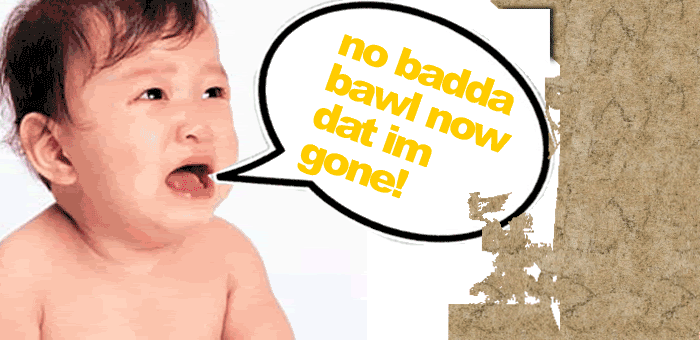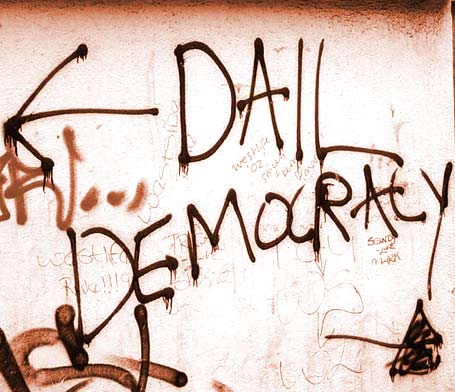
Tuesday, February 08, 2005
A Walls As Good As It Gets
 In the past year, Dublin walls have become increasingly stamped over with stencil graffiti, some like the ‘these are dangerous times’ series evoked the anti-war sentiment that blistered last year. Others advertised events like Reclaim the Streets, one even distorted the Coke font into Killer Cola, with an unambiguous message about their crimes in Colombia. Apparently, so the rumour goes, once spotted Coke had hired cleaners out straight away, such is the force of street art.
In the past year, Dublin walls have become increasingly stamped over with stencil graffiti, some like the ‘these are dangerous times’ series evoked the anti-war sentiment that blistered last year. Others advertised events like Reclaim the Streets, one even distorted the Coke font into Killer Cola, with an unambiguous message about their crimes in Colombia. Apparently, so the rumour goes, once spotted Coke had hired cleaners out straight away, such is the force of street art.Perhaps that's why some multinational corporations, such as Nike, have been chasing famous stencil artists such as British artist Banksy to design their latest advertising logos. Banksy is perhaps the world's best-known stenciler, having recently designed the Think Tank album cover for British pop band Blur.
That there are similarities between stencil graffiti and corporate logos is no surprise. Logos have become the world as we understand it, stencil graphics work on the same level, subverting them with information compressed into single images that are instantly recognisable, and repeatable. Stencils use the aesthetic principles of advertising to suggest an alternative. Stencil graffiti is a backlash against boring surroundings, advertisements are everywhere there to find you, the messages of stencilled imagery and slogans ambushes in the same style. Unexpected because we have become so accustomed to seeing our cities walls decorated with the sell.
Wholly subversive, Banksy’s stencils erode authority figures; police men with smiley faces, monkeys bearing weapons of mass destruction and ‘laugh now but one day we’ll be in charge’ on sandwich boards. If stencil art is unexpected walking down the street, then so can the message perturb and cut across the expectations that stem from mainstream dialogues. Among Banksy’s best pieces is a masked anti-capitalist flinging a bunch of flowers. Another huge piece featured stampeding stock exchange types throwing their cheque books at police; in red letters ’cheque book vandalism’ got the point across. Like all great art, he doesn’t keep stump on the galleries either, infamous for stencilling ‘mind the crap’ on the steps leading into the Tate the night before the Turner prize was given to an unfolded bed. Traditional landmarks have been signed with ‘this is not a photo opportunity’, while blank white walls have been left with tags like "By Order National Highways Agency This Wall Is A Designated Graffiti Area", skip to a few days later and people will have obediently replied. For six months after 9-11, he moved temporarily away from imagery finding it easier to convey meaning in text based stencils like ’wrong war’ and ’bury the dead, not the truth.’
Banksy’s most famous series is the teams of tooled up rats dismantling the city’s artefacts. Representing all the powerless misrepresented losers coming back, after a rethink, grouped together. Three such rats gather across the Thames from Westminster, one on look out, and two aiming a mortar at parliament. It doesn’t matter if their trajectory is off, the point hits. At a recent London solo exhibition called Turf War, Banksy stencilled two cows from top to bottom with pictures of arrows and Anglo-Saxon faces, with the note: "the average African receives less in subsidies per head than an EU cow". Many have begun to question to question his credibility after his Turf War exhibitions, criticising him for doing too much day work and not enough nights. But for an stenciler that sprayed ‘designated riot zone’ on the steps of Trafalgar Square the night before Mayday; outdoing his own wit has become an increasingly arduous challenge, not to say risky.
As his website intro states ‘this revolution is for display purposes only.’ Introduced to Britain by anarcho-punks Crass at Thatcher’s height, outbursts of stencilling are always linked to political rebellion. Like adbusting (where the corporate message of a billboard is distorted to a political statement and movements like reclaim the streets, Banksy’s art is not his. It is instinctively public, and meant for participation. It is about the reclamation of our daily environment, and the creation of a public system of signs and meanings which lie outside the advertisements which stain every wall you care to look at. It’s using the tactics of mass consumerism against it, for an entirely different end. Plenty of people moan that graffiti is ugly, but as Banksy says ‘it's a product of society so it's bound to be pretty ugly.’ So arm yourself (card board is free and spray comes at €8), this is an art revolution we can all take part in. See you on the streets, hoodies up.
Labels: Art, Banksy, Politics, Street Art
About Soundtracksforthem specialises in iconoclastic takes on culture, politics, and more shite from the underbelly of your keyboard. A still-born group blog with a recent surge of different contributers but mainly maintained by James R. Big up all the contributers and posse regardless of churn out rate: Kyle Browne, Reeuq, Cogsy, Chief, X-ie phader/Krossie, Howard Devoto, Dara, Ronan and Mark Furlong. Send your wishes and aspirations to antropheatgmail.com
Label Cluster
In no certain order...
Politics,
Guest Bloggers
Interviews,
Music,
Internet,
Guest Bloggers,
Travel,
Blogging,
TV,
Society,
Film,
Gig Reviews,
Art,
Media.
The Neverending Blogroll
A Womb Of Her Own
Arse End Of Ireland
BlissBlog
BBC One Music Blog
Blackdown Sound Boy
Buckfast For Breakfast
Customer Servitude
Counago & Spaves
C8
Candy PDF Mag
Guttabreakz
House is a Feeling
Homoludo
Infactah
Indymedia
Indie Hour Blog
Jim Carroll
kABooGIE MusIC
Kid Kameleon
Kick Magazine Toronto
Libcom
Matt Vinyl
Modern Cadence
Mongrel
Nialler9
One For The Road
Old Rotten Hat
Pitchfork
Salvo
Spannered
Sigla
Test
Thumped
Newish Journalism
TV Is Crying
Uncarved
Una Rocks
Urban75
Weareie
WSM
Wooster
Village Magazine
Radical Urban Theory
Archives
February 2002
October 2002
April 2003
September 2003
November 2003
December 2003
January 2004
February 2004
March 2004
June 2004
September 2004
January 2005
February 2005
March 2005
April 2005
June 2005
July 2005
August 2005
September 2005
October 2005
November 2005
December 2005
January 2006
February 2006
March 2006
April 2006
May 2006
June 2006
July 2006
August 2006
September 2006
October 2006
November 2006
December 2006
January 2007
February 2007
March 2007
April 2007
May 2007
June 2007
July 2007
August 2007
September 2007
October 2007
November 2007
December 2007
January 2008
February 2008
March 2008
The return of Chris Morris
Another damn thing about Doyle's
A Fibbers For Our Time
Doo Noo Na Nooo..Wop..Wop..Wop -Sergio Leone
Invisible Agent: For What Its Worth
Buckfast: I Thought This Relationship Was Over.
All It Took Was A Mandolin
Mutiny Is The Conscience Of War
Obesity With That Sir?
Corrie With A Bad Dose of The Richey Edwards
